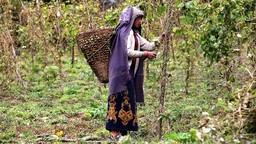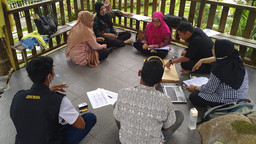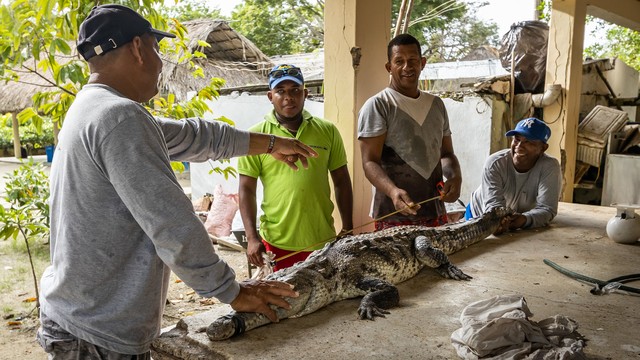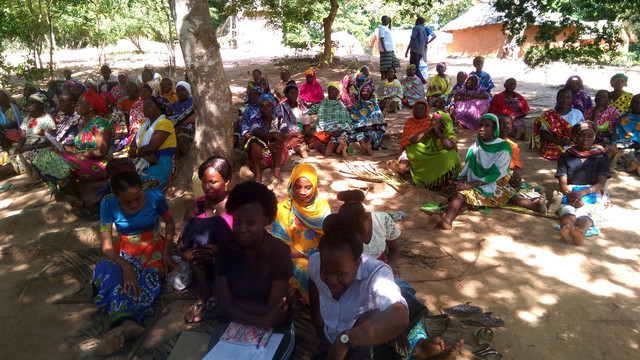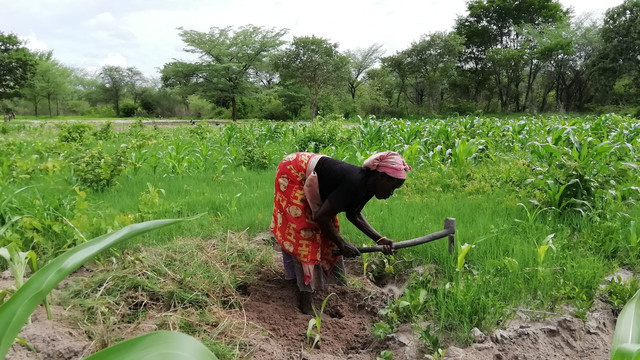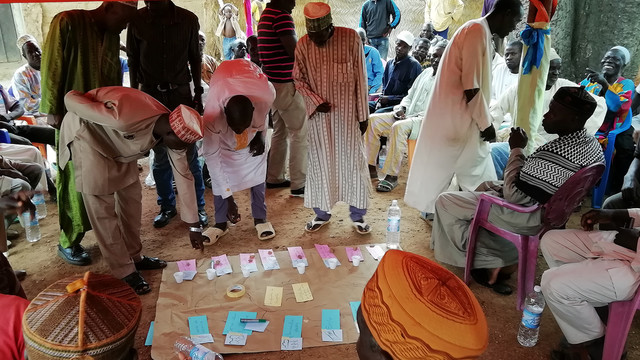Site-level assessment of governance and equity (SAGE)
IIED and partners in the SAGE initiative have developed and are scaling up a relatively simple, low-cost tool for stakeholders and rightsholders in protected or conserved areas to assess governance and equity. Building on very positive experiences to date, a SAGE version 2.0 has been released as we change our focus from methodology development to support for scaling up.
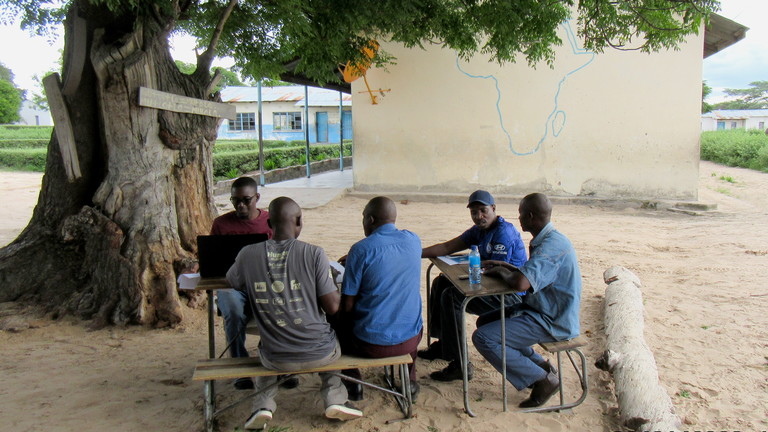
Community men using the site-level assessment of governance and equity to assess protected area governance in Zambia (Photo: Phil Franks, IIED)
Site-level assessment of governance and equity (SAGE) is one of three tools for stakeholders and rightsholders to themselves assess the social impacts, governance and equity of their conservation efforts. The other two tools are social assessment for protected and conserved areas (SAPA) and governance assessment for protected and conserved areas (GAPA).
Guidance is available on which tool to use in which contexts. This page explores SAGE in more detail.
Background
Led by IIED, the SAGE initiative aims to improve the governance and equity of a protected and conserved area (PCA) and any associated measures designed to support conservation. It is based on the relatively simple SAGE methodology, which enables PCA stakeholders to assess the status of governance and equity, plan actions to improve, and monitor progress.
The importance of governance to conservation was highlighted at the IUCN World Parks Congress in 2003, and subsequently in the Convention on Biological Diversity’s (CBD) programme of work on protected areas developed in 2004. More recently, Aichi target 11 of the CBD Strategic Plan 2011-20 states that protected areas (PAs) should be equitably managed.
The recently agreed Kunming-Montreal Global Biodiversity Framework (GBF) rightly changes the emphasis to equity in governance. Target 3 on improving and expanding area-based conservation (the so-called 30x30 target) includes a commitment to equitable governance of PCAs, and the number of sites that have used SAGE (or a similar tool) is listed as an indicator or progress.
Equity in conservation is about respect of actors and their rights; decision-making, transparency, accountability, dispute resolution, and how costs and benefits are distributed – in other words largely a matter of governance. Developed through a collaborative effort led by IIED, this framing of equity was endorsed by the CBD's Conference of the Parties (COP14) (PDF) in 2018.
What is IIED doing?
The SAGE initiative is a joint effort of a number of conservation agencies, NGOs and research organisations led by IIED.
Drawing on our collective understanding and experience, SAGE assesses the quality of governance, including equity, using a simple framework of ten equitable governance principles based on that of IUCN (see table below). Each principle is further unpacked into five themes that provide a comprehensive and practical understanding of governance.
Framework of equitable governance principles
| Equity: recognition | 1. Respect for resource rights and human rights of community members |
| 2. Respect of all relevant actors and their knowledge, values and institutions | |
| Equity: procedure | 3. Effective participation of all relevant actors in decision making |
| 4. Transparency, information sharing and accountability for actions and inactions | |
| 5. Access to justice, including effective dispute resolution processes | |
| 6. Effective and fair law enforcement | |
| Equity: distribution | 7. Effective mitigation of negative impacts on community members |
| 8. Equitable sharing of benefits among relevant actors | |
| Other | 9. Achievement of conservation and other objectives |
| 10. Effective coordination and collaboration between actors, sectors and levels |
We developed the first version of the SAGE methodology in 2019. In contrast to SAPA and GAPA, which focus only on improving social impacts and governance at a site, SAGE also has the aim of providing information for reporting on PCA governance and equity to national and global levels.
We conducted a first round of SAGE pilots in late 2019 in nine countries: Cambodia, Vietnam, Philippines, Chad, Cameroon, Tanzania, Zambia, Greece and the UK.
SAGE version 1.0 has now been used in many more countries, including Bolivia, Colombia, Kenya, Côte d'Ivoire, Malawi, Lesotho, Madagascar, Mozambique, Democratic Republic of Congo, Uganda, Seychelles, Nepal and Indonesia. These assessments have covered marine and terrestrial sites that are owned and managed by state agencies, local communities and Indigenous Peoples.
In response to the COVID-19 pandemic we developed, in partnership with IUCN and GIZ, a virtual interactive training course for SAGE facilitators that enables SAGE to be used without a need for in-person training.
If you would like to use SAGE another option is to contact one of the growing number of experienced SAGE facilitators.
We are now formally releasing SAGE version 2.0, including the SAGE manual for facilitators and an Excel-based SAGE data entry and analysis tool (xlsx), and changing our focus from methodology development to support for scaling up.
We are aiming for uptake by 2030 comparable to that of Protected Area Management Effectiveness evaluations after 10 years (eg 5,000 sites) and that this will make a significant contribution to the transformative ambition of the new GBF.
This includes using SAGE as part of the IUCN green list process, with social safeguards and integrated with management effectiveness evaluation tools.
- Watch videos of SAGE being used at Evros Delta National Park in Greece, Mount Kalatungan Range Natural Park in the Philippines, and Lumo Conservancy in Kenya.
SAGE – what is it and why do it?
Essentially, SAGE is a stakeholder workshop in two parts. In the first part, different stakeholder/rightsholder/actor groups complete the SAGE questionnaire in their separate groups. The SAGE questionnaire is similar to the Management Effectiveness Tracking Tool (METT) and, like METT, SAGE also captures qualitative information including specific governance challenges identified by different stakeholders, reasons for differences in perspective, and suggested actions to address the challenges.
In the second part these actor groups come together to share their findings and their ideas for actions to improve governance and equity. This takes from one to three days according to how many of the ten principles are covered, and time needed for discussion.
The chart below shows the scores (out of a maximum of three) from a SAGE in Zambia, including the different perspectives of different stakeholder groups (such as PAs managers and communities, men and women).
Many users also comment that SAGE helps them understand governance and equity and that the actor-led, interactive process of SAGE builds trust and enables Indigenous Peoples and local communities, including any maginalised groups, to have a stronger voice.
- Read about SAGE and its early contributions to governance of area-based conservation in Bolivia, Kenya and Zambia
Download the Excel-based tools for data entry and analysis
- For seven groups (xlsx)
- For seven groups (xlsx) – with example data from Kenya
Get in touch
If you would like to know more about SAGE, contact Ruth Pinto (ruth.pinto@iied.org) or Phil Franks (phil.franks@iied.org).
News and updates
Publications
Additional resources
Video: Site Assessment on Governance and Equity (SAGE) in Lumo Conservancy, Kenya, Kenya Wildlife Conservancies Association (January 2023)
SAPA, SAGE or GAPA? Tools for assessing the social impacts, governance, and equity of conservation, Phil Franks, Ruth Pinto (2020), Project material | en français
IUCN web page: SAGE: a brand new tool for governance and equity assessment
Video: Randilen Wildlife Management Area SAGE Workshop, Tanzania (November 2019)
Understanding and assessing equity in protected area conservation: a matter of governance, rights, social impacts and human wellbeing, Phil Franks, Francesca Booker, Dilys Roe (2018), IIED Issue paper
Partners
Gesellschaft für Internationale Zusammenarbeit (GIZ)
International Union for Conservation of Nature (IUCN)
In addition to these formal partners, more than 15 other conservation agencies, NGOs and research organisations are collaborating in the SAGE initiative
